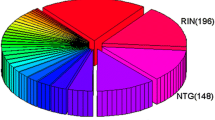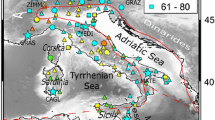Abstract
An efficient procedure is proposed to define realistic lower limits of velocity errors of a non-permanent GPS station (NPS), i.e., a station where the antenna is installed and operates for short time periods, typically 10–20 days per year. Moreover, the proposed method is aimed at being independent of standard GPS data processing. The key is to subsample appropriately the coordinate time series of several continuous GPS stations situated nearby or inside the considered NPS network, in order to simulate the NPS behavior and to estimate the velocity errors associated with the subsampling procedure. The obtained data are used as lower limits to accept or correct the error estimates provided by standard data processing. The proposed approach is applied to data from the dense, non-permanent network in the Central Apennine of Italy based on a sequence of solutions for the overlapping time spans 1999–2003, 1999–2004, 1999–2005 and 1999–2007. Both the original and error-corrected velocity patterns are used to compute the strain rate fields. The comparison between the corresponding results reveals large differences that could lead to divergent interpretations about the kinematics of the study area.








Similar content being viewed by others
References
Altamimi Z, Collilieux X, Legrand J, Garayt B, Boucher C (2007) ITRF2005: a new release of the International Terrestrial Reference Frame based on time series of station positions and Earth Orientation Parameters. J Geophys Res 112:B09401. doi:10.1029/2007JB004949 doi:10.1029/2007JB004949
Anzidei M, Baldi P, Pesci A, Esposito A, Galvani A, Loddo F, Cristofoletti P, Massucci A, Baldi P, Cenni N, Fabris M, Zanutta A (2008) Kinematics of a landslide derived from archival photogrammetry and GPS data. Geomorphology 102(3–4):435–444. doi:10.1016/j.geomorph.2008.04.027
Casula G, Dubbini M, Galeandro A (2007) Modeling environmental bias and computing velocity field from data of Terra Nova Bay network in Antarctica by means of a quasi-observation processing approach. US Geological Survey and the National Academies, USGS OF-2007-1041, doi:10.3133/of2007-1047.srp054
Cenni N, Baldi P, Mantovani E, Ferrini M, Viti M, D’Intinosante V, Babbucci D, Albarello D (2008) Short-term (geodetic) and long-term (geological) deformation pattern in the Northern Apennines. Boll Soc Geol Ital 127(1):93–104
Cristofoletti P, Esposito A, Anzidei M (2006) A GIS method for geodetic applications: the Central Apennine geodetic network (GeoNetGIS). Quaderni di Geofisica 44. Istituto Nazionale di Geofisica e Vulcanologia, Rome
Dach R, Hugentobler U, Fridez P (2007) Bernese GPS Software v.5.0 tutorial. Astronomical Institute, University of Bern, Bern
Dong D, Herring TA, King RW (1998) Estimating regional deformation from a combination of space and terrestrial geodetic data. J Geod 72:200–214. doi:10.1007/s001900050161
Dong D, Fang P, Bock Y, Cheng MK, Miyazaki S (2002) Anatomy of apparent seasonal variation from GPS-derived site position. J Geophys Res 107(B4):2075. doi:10.1029/2001JB000573 doi:10.1029/2001JB000573
Leonard LJ, Hyndman RD, Mazzotti S, Nykolaishen L, Schmidt M, Hippchen S (2007) Current deformation in the northern Canadian Cordillera inferred from GPS measurements. J Geophys Res 112(B11401). doi:10.1029/2007/2007JB005061 doi:10.1029/2007JB005061
Lyard F, Lefevre F, Letellier T, Francis O (2006) Modelling the global ocean tides: insights from FES2004. Ocean Dyn 56:394–415. doi:10.1007/s10236-006-0086-x
Mao A, Harrison CGA, Dixon TH (1999) Noise in GPS coordinate time series. J Geophys Res 104(B2):2797–2816. doi:10.1029/1998JB900033
Mazzotti S, Dragert H, Henton J, Schmidt M, Hyndman RD, James TS, Lu Y, Craymer M (2003) Current tectonics of northern Cascadia from a decade of GPS measurements. J Geophys Res 108(B12):2554. doi:10.1029/2003JB002653 doi:10.1029/2003JB002653
McCarthy DD, Petit G (2004) IERS Conventions (2003), IERS Technical Note 32. Available at the International Earth and Rotations Service (http://www.iers.org)
Mora P, Baldi P, Casula G, Fabris M, Ghirotti M, Mazzini E, Pesci A (2003) Global positioning systems and digital photogrammetry for the monitoring of mass movements: application to the Ca’ di Malta landslide (Northern Apennines, Italy). Eng Geol 68:103–121. doi:10.1016/S0013-7952(02)00200-4
Pesci A, Teza G (2007) Strain rate analysis over the central Apennines from GPS velocities: the development of a new free software. Boll Geod Sci Affini 56:69–88
Ray J, Altamimi Z, Collilieux X, van Dam T (2008) Anomalous harmonics in the spectra of GPS position estimates. GPS Solut 12(1):55–64. doi:10.1007/s10291-007-0067-7
Serpelloni E, Casula G, Galvani A, Anzidei M, Baldi P (2006) Data analysis of permanent GPS networks in Italy and surrounding regions: application of a distributed processing approach. Ann Geophys Italy 49(4/5):897–928
Shen Z-K, Jackson DD, Ge BX (1996) Crustal deformation across and beyond the Los Angeles basin from geodetic measurements. J Geophys Res 101(B12):27957–27980. doi:10.1029/96JB02544
Teza G, Pesci A, Galgaro A (2008) Grid_strain and grid_strain3: software packages for strain field computation in 2D and 3D environment. Comput Geosci 34(9):1142–1153. doi:10.1016/j.cageo.2007.07.006
Webb FH, Zumberge JF (1993) An introduction to GIPSY/OASIS-II precision software for the analysis of data from the global positioning system, Publication No. D-11088. JPL, Pasadena CA
Williams SDP (2003) The effect of colored noise on the uncertainties of rates estimated from geodetic time series. J Geod 76(9–10):483–494. doi:10.1007/s00190-002-0283-4
Williams SDP, Bock Y, Fang P, Jamason P, Nikolaidis RM, Prawirodirdjo L, Miller M, Johnson DJ (2004) Error analysis of continuous GPS position time series. J Geophys Res 109:B03412. doi:10.1029/2003JB002741 doi:10.1029/2003JB002741
Author information
Authors and Affiliations
Corresponding author
Rights and permissions
About this article
Cite this article
Pesci, A., Teza, G. & Casula, G. Improving strain rate estimation from velocity data of non-permanent GPS stations: the Central Apennine study case (Italy). GPS Solut 13, 249–261 (2009). https://doi.org/10.1007/s10291-009-0118-3
Received:
Accepted:
Published:
Issue Date:
DOI: https://doi.org/10.1007/s10291-009-0118-3




